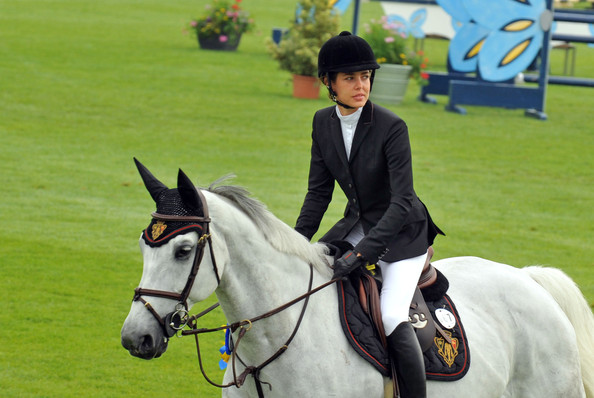What to Wear When You Go Riding
 1. Helmet 1. Helmet
Most instructors will have these available for
beginners and if your instructor does not insist that you wear one look elsewhere. It is a matter of
safety that you wear a helmet- without one you can die. Try to avoid plastic helmets with vents as these
can get branches caught in them and rip you off the horse when you least expect it. It is a good idea to
be fitted at your tack store for your own helmet once you are sure you want to continue riding. A properly
fitting helmet makes things far more enjoyable than one that is too tight or too loose.
2. Long pants/ Stretch Pants/ Breeches
You want to protect
your legs from being pinched and injured, so wear pants. Stretch pants and breeches offer good protection and
won't irritate the skin as much when rubbed and stretched by the riding. They also offer more range of motion
than jeans and are more comfortable for long days in the saddle.
3. Boots with a heel
Make no mistake, a heel is an
absolute MUST for your horseback riding. Boots with a smooth sole and one inch heel are often required and
definitely recommended. Consider for a moment that you wear a boot with no heel and your foot slips through the
stirrup and is trapped. Then your horse spooks (I have had this happen) and you cannot get your foot free so
you can control your horse. You are panicked the horse is panicked. If you were to fall off your horse you
would simply be dragged along the ground until they stopped. Heels prevent fatalities.
4. Tucked in and button free shirt
Though most people
think of western riding in a button down, patterned shirt, but it is important to NOT wear one unless you are
very well trained as the buttons can get caught in the saddle.
5. Neat and pinned back or braided hair
Keeping your hair
out of your face will help keep you focused on riding and prevent mishaps from accidently pulling on the reins
or giving mixed signals because you're fussing with your hair. If you have hair that tends to wisp or fly-away,
consider a hair net to keep it from bothering your face.
6. Riding gloves
Riding gloves help to keep your hands
safe from the elements and even, in some cases, lessen the severity of blisters. They are a necessity in winter
but definitely something nice to have all year round.
7. Half chaps
Leather or suede is the way to go with these
leg guards. They offer extra grip while you're in the saddle and additional protection from the
elements.
Related Articles
Common Horse Riding Terms
Most Famous Racing Horses
5 Fastest Horses in Kentucky Derby History
What to Expect at Your First Riding Lesson
Top Five Racing Breeds
Tips for Horseback Riding
What to Look for in a Horse Riding
Instructor
Steering Your Horse With No Reins
Tips for Picking a Winning Race Horse
Horseback Riding Equipment - What You Need to
Have
What to Wear When You Go Riding
The 5 Most Famous Horse Races
Questions to Ask Potential Riding
Instructors
Ride and Tie- A Fun Horse Riding Pastime
Quick Tips for Breaking a Horse
Learning to Bail or Hang On
|